 |
きょう土の文化ざい
Cultural assets in our hometown
Patrimônio Cultural Regional
地いきには,どんな文化ざいがあるのでしょうか。
What cultural assets are there in our area?
Quais tipos de patrimônios culturais encontramos na região?
What cultural assets are there in our area?
Quais tipos de patrimônios culturais encontramos na região?
 |
 | 「常総市には,すばらしい文化ざいがたくさんのこされているそうだよ。」 “In Joso City, we have very valuable cultural assets.” Parece que na cidade de Joso muitos patrimônios culturais são conservados. |
 | 「文化ざいのことを,みんなで調べてみたいね。」 “Why don't we research those cultural assets?” Gostaria de pesquisar com todos sobre os patrimônios culturais. |
 | 「文化ざいについてくわしい人にお話を聞いたり,しりょうを集めたりしようよ。」 “Let's learn about them from experts and collect materials.” Vamos conversar com alguém que entende e ajuntar material sobre o patrimônio cultural. |
文化ざい
Cultural assets
Patrimônio cultural
文化ざいとは「昔からの文化として,ねうちがあるもの」という意味です。
Cultural assets are items that have been passed down through generations because of their cultural value.
Patrimônio cultural significa aquilo que possui valor cultural desde o passado.
特にきちょうなものは,国や県,市の指定文化ざいとして守られています。
The especially valuable ones are protected by the country, prefecture, or city as designated cultural properties.
Especialmente os mais valiosos são protegidos sendo patrimônios culturais designados pelo país ou pela província.
Cultural assets
Patrimônio cultural
文化ざいとは「昔からの文化として,ねうちがあるもの」という意味です。
Cultural assets are items that have been passed down through generations because of their cultural value.
Patrimônio cultural significa aquilo que possui valor cultural desde o passado.
特にきちょうなものは,国や県,市の指定文化ざいとして守られています。
The especially valuable ones are protected by the country, prefecture, or city as designated cultural properties.
Especialmente os mais valiosos são protegidos sendo patrimônios culturais designados pelo país ou pela província.
| 調べること What to research O que pesquisar | 調べ方 How to research Como pesquisar |
| ●どんな文化ざいがあるか。 What kinds of cultural assets can we find? Quais são os patrimônios culturais que existem? ●どのように伝えられてきたのか。 How have they been passed down to our generation? Como eles são transmitidos? | ●パンフレットやインターネットを活用して調べる。 Research with brochures and on the Internet. Pesquisar utilizando panfletos ou a internet. ●見学やインタビューをもとにして調べる。 Research by taking a study tour and interviewing. Pesquisar através de visitas ou entrevistas. |
あきらさんたちは、水海道風土博物館「坂野家住宅」をたずねてみることにしました。
Akira and his friends decided to visit the Sakano Family Residence, which is part of the Mitsukaido Cultural Museum.
Akira e seus amigos decidiram visitar a Casa da família Sakano do Museu Cultural de Mitsukaido.
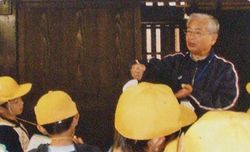 |
 △表門(薬医門) Front gate (Yakuimon) Entrada frontal (Yakuimon) |  △蔀戸 Shitomido (a wooden door) Porta Shitomido |
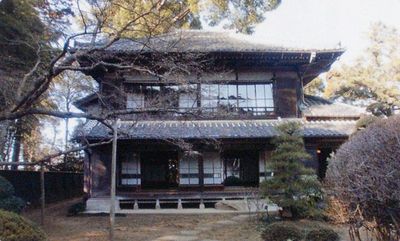 △月波楼(書院) Gepparo (a drawing room) Geppa-ro (Sala de estar) | 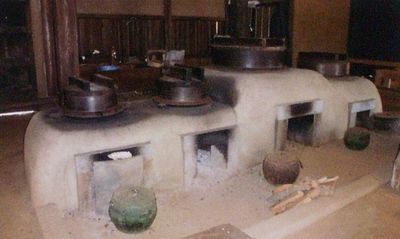 △かまど Furnace Fogão a lenha |
 | 水海道風土博物館長さんの話 Comment from the Curator of Mitsukaido Cultural Museum História do diretor do Museu Cultural de Mitsukaido |
| 坂野家住宅は「豪農の家」としての昔の生活がわかります。特に主屋と表門(薬医門)は国の重要指定文化財です。昔のものもたくさんのこされており,当時の生活の様子を知ることができます。 If you visit the Sakano Family Residence, you will learn how a typical wealthy farming family lived in the past. In particular, the main building and the front gate (Yakuimon) are designated as important cultural properties. The old devices have been preserved, so we can learn what the life was like in old times. A casa da família Sakano é uma casa de latifundiário onde é possível entender sobre a vida do passado. Especialmente a casa principal e a entrada frontal (Yakuimon) são designados como patrimônio cultural importante do país. Muitas coisas antigas estão preservadas, sendo possível saber como era a vida da época. | |
| 昔,二宮尊徳も坂野家に宿泊して仕事をしたそうです。現在では,えい画などのさつえいも数多く行われています。 Ninomiya Sontoku also stayed and worked at Sakano Family Residence. Currently, movies are often filmed here. Parece que antigamente, Sontoku Ninomiya também se acomodou e utilizou a casa da família Sakano para trabalhar. Atualmente é muito utilizada para filmagem para cinema e outros. | |
| この坂野家住宅は,地いきを支えてきた先人たちのすがたや努力を学ぶことのできる貴重な宝物です。みなさんも,ぜひ見学に来てください。 This residence is a treasure that teaches us about our ancestors, who diligently contributed to the development of this region. I hope you all visit this residence. Esta casa da família Sakano é um tesouro valioso para aprendermos como eram nossos antepassados e como se esforçaram para apoiar a região. Espero que todos venham nos visitar. | |
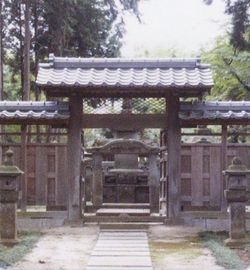 △千姫の墓(弘経寺) Grave of Sen Hime (Gugyo-ji Temple) Túmulo de Senhime (Templo budista Gugyo-ji) |  Wooden standing figure of Prince Shotoku (Muryo-ji Temple) Estátua de madeira de Shotoku Taishi (Templo budista Muryo-ji) | 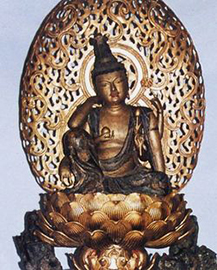 △木造如意輪観音坐像 (法性寺) Wooden seated figure of Nyoirinkannon (Hossho-ji Temple) Estátua de madeira de Nyoirin Kannon (Templo budista Hosshou-ji) |
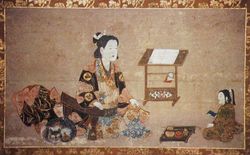 △千姫姿絵(弘経寺) Portrait of Sen Hime (Gugyo-ji Temple) Pintura de Senhime (Templo budista Gugyo-ji) | 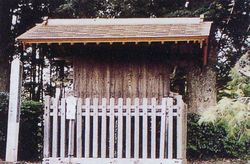 △高札台(崎房) Kosatsudai (Sakibusa) Painel de informações (Sasabusa) |
 △弘経寺 Gugyo-ji Temple Templo budista Gugyo-ji |  △干姫行列 Sen Hime parade Procissão de Senhime |
 | 弘経寺主管さんの話 A comment from the manager of Gugyo-ji Temple História do monge do Templo budista Gugyo-ji |
| 弘経寺では,毎年桜の季節に「天樹祭」を行います。この祭りの名前は,徳川家康の孫の千姫が「天樹院」とよばれたためです。 千姫は,弘経寺に本堂を寄進したり自分のお墓をたてることを願ったりしたそうです。 At Gugyo-ji Temple, we celebrate the ”Tenju Festival.” This festival was named after ”Tenju-in,” another name for Sen Hime. Sen Hime was a granddaughter of Tokugawa Ieyasu. Sen Hime donated the main hall to Gugyo-ji Temple in hopes that her grave would be built at the temple. No templo budista Gugyo-ji realizamos todos anos na estação do sakura o Festival Tenjyusai. O festival tem esse nome porque a Senhime que era neta de Ieyasu Tokugawa era chamada de Tenjyuin. Senhime fez a doação do salão principal do templo budista Gugyo-ji e desejou que fosse sepultada nele. | |
| 天樹祭の日には,きれいな着物を着た「千姫様」が,弘経寺にある千姫のお墓におまいりをします。 この天樹祭に,毎年たくさんの方に来ていただき,うれしく思います。 On the day of the Tenju Festival, ladies wearing beautiful ”Sen Hime” costumes go to her grave to pray. We are glad that many people come to this festival every year. No dia do festival Tenjyusai, vossa majestade Senhime vestindo um belo kimono visita seu túmulo no templo budista Gugyo-ji. Fico feliz que todos os anos muitas pessoas compareçam neste festival Tenjyusai. | |
地いきにつたわる行事
Traditional regional events
Eventos transmitidos na região
地いきでつづけられている行事には,どんなものがあるでしょうか。
What traditional events have you experienced in this region?
Quais os tipos de eventos que continuam sendo realizados na região?
What traditional events have you experienced in this region?
Quais os tipos de eventos que continuam sendo realizados na região?
 | 「わたしは,お祭りのときにたいこをたたいたことがあるわ。」 “I played the drum at the festival.” Uma vez eu já toquei taiko no festival. |
 | 「ぼくは,おみこしをかついだことがあるよ。楽しかったな。」 “I carried a mikoshi portable shrine. It was so fun.” Uma vez eu carreguei o omikoshi. Foi muito divertido. |
 | 「いろいろなお祭りがありそうだね。昔からつづけられてきたお祭りのことを知リたいね。」 “There are a lot of traditional festivals. I would like to know more about them.” Parece que existem vários festivais. Gostaria de saber quais são os festivais que continuam sendo realizados desde antigamente. |
自分たちの地いきの行事を調べてみましょう。
Let's see what events there are in our region.
Vamos pesquisar os eventos realizados na região de cada um.
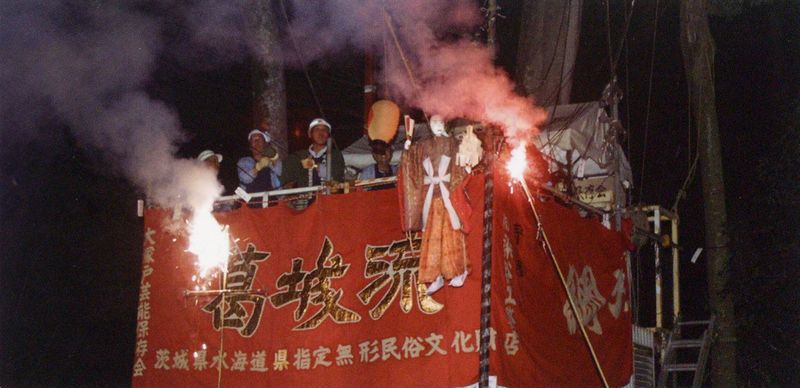 △からくり綱火(一言主神社) Karakuri Tsunabi fireworks (Hitokotonushi Shrine) Karakuri-tsunabi (Templo xintoísta Hitokotonushi) |
 △水海道祇園祭 Mitsukaido Gion Festival Festival Gion de Mitsukaido |  △石下祇園祭 Ishige Gion Festival Festival Gion de Ishige |
地いきにのこる行事には,どんなねがいがこめられているのでしょうか。
What do people wish for as part of these traditional local events?
Qual é a intenção contida nos eventos mantidos da região.
What do people wish for as part of these traditional local events?
Qual é a intenção contida nos eventos mantidos da região.
あきらさんたちは,地いきにのこる行事についても調べてみました。
Akira and his friends also researched other local festivals.
Akira e seus amigos decidiram pesquisar sobre os eventos mantidos na região.
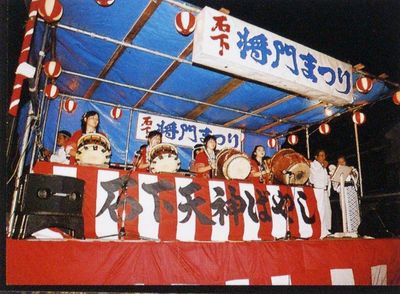 △石下天神ばやし(原宿の天満宮) Ishige Tenjinbayashi (Harajuku Tenmangu) Ishige Tenjin-bayashi (Templo xintoísta Tenmangu de Harajyuku) |  △天神ばやしの練習の様子 Children practicing the Tenjin Bayashi Treino de Tenjin-bayashi |
 | 天神ばやし保存会の人の話 Comment from a member of the preservation society História do integrante do grupo de conservação do Tenshin-bayashi |
| その年の実りに感しゃし,次の年の豊作をいのって,祭りが行われます。祭りは,昔から人々の大きな楽しみの一つであり,地いきで大事にされてきました。 This festival is held in appreciation for the abundant harvest in the current year and to pray for an abundant harvest in the next year. Since long ago, this festival has been a great source of enjoyment for local people who cherished and preserved it. Realizamos o festival para agradecer a colheita do ano e desejar uma boa safra no próximo ano. O festival, muito esperado por todos desde antigamente, é muito valorizado na região. | |
| 保存会では,「子どもたちにもおはやしを受けついでほしい。」という思いで,練習会を開いています。昔から伝わる行事として,大切にこのおはやしを守り続けてほしいとねがっています。 At the preservation society, we provide practice sessions and hope that the local children will carry on the tradition by learning how to play the musical instruments. I strongly hope that they preserve and cherish the music as part of the traditional event. No grupo de conservação realizamos os treinos com a intenção de transmitir o Ohayashi para as crianças também. Desejo que este Ohayashi continue sendo conservado com muito cuidado, por ser um evento transmitido desde antigamente. | |
 △八朔祭りでの,ちの輪くぐり(大生郷天満宮) Chinowakuguri ceremony at the Hassaku Festival (Onogo Tenmangu Shrine) Passagem através do círculo Chinowa no festival Hassaku (Templo xintoísta Tenmangu de Onogo) | 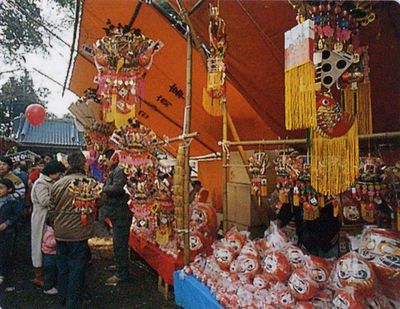 △だるま護摩 (安楽寺 - 元三大師 -) Daruma-goma Ritual (Anrakuji - Ganzan Daishi -) Daruma-goma (Ganzaitaishi, templo budista Anraku-ji) |
まとめよう
Summarize what you learned...
Vamos resumir
調べてわかったことをまとめて,伝え合おう。
Summarize what you learned and share it with your friends.
Vamos resumir o que aprendemos na pesquisa e contar entre si.
Summarize what you learned and share it with your friends.
Vamos resumir o que aprendemos na pesquisa e contar entre si.
あきらさんたちは,調べてわかったことを「れきしマップ」にまとめて,みんなに伝えました。
Akira and his friends summarized what they learned on their historical map and shared it.
Akira e seus amigos fizeram um resumo em um Mapa Histórico com o que aprenderam pesquisando e contaram para todos.
自分たちにできることを考えてみよう。
Think about what you can do.
Vamos pensar no que cada um pode fazer.
| れきしマップ Historical map Mapa Histórico | |||||||||||||||||||||||||||||||||||||||||||||||||||||||||||||||||||||||||||||||||||||||||||||
 | 文化ざい |  | お祭り | ||||||||||||||||||||||||||||||||||||||||||||||||||||||||||||||||||||||||||||||||||||||||||
| Festival | Cultural assets | ||||||||||||||||||||||||||||||||||||||||||||||||||||||||||||||||||||||||||||||||||||||||||||
| festival | Patrimônio cultural | ||||||||||||||||||||||||||||||||||||||||||||||||||||||||||||||||||||||||||||||||||||||||||||
 | |||||||||||||||||||||||||||||||||||||||||||||||||||||||||||||||||||||||||||||||||||||||||||||
| |||||||||||||||||||||||||||||||||||||||||||||||||||||||||||||||||||||||||||||||||||||||||||||